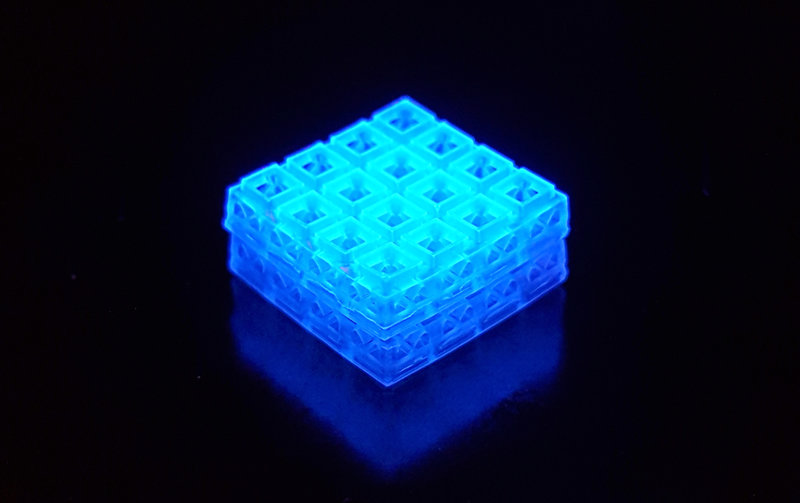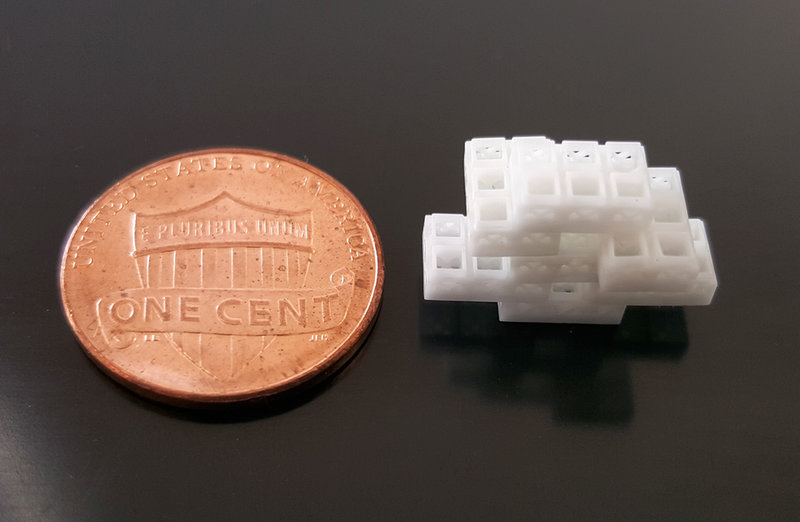3D Printing
Building blocks:
3D-printed ‘bone bricks’ could help save limbs
Advances in 3D printing are presenting new opportunities in the healing of wounds and catastrophic bone breaks, among other areas. Could 3D-printed ‘bone bricks’ help to save limbs in a setting as challenging as the ongoing conflict in Syria? Chris Lo reports.
“O
ur lives and the lives of future generations do not only depend on the conflicts that take place, but also on the solutions we offer in response to them.”
Those words, from peace activist Dr Widad Akreyi, express a sentiment that rings true of the ongoing and brutal conflict in Syria, the devastating legacy of which is already plain to see. The war has forced millions of Syrians to flee their homes, ending up displaced in their own country or seeking shelter in refugee camps abroad, with 13.5 million described by the UN as displaced persons needing humanitarian assistance.
Another legacy of the war in Syria is the surge of civilian deaths and catastrophic limb injuries caused by mines and aerial bombing, with improvised ‘barrel bombs’ killing more than 11,000 Syrian civilians between 2012 and 2018, according to Amnesty International. Those who survive these blasts often have such badly broken bones that amputation is the only option, particularly in remote regions without access to advanced surgical procedures.
“Sadly, there are frequent situations where amputation is needed,” said Manchester University NHS Foundation Trust orthopaedic surgeon Amer Shoaib, who has volunteered at Syrian refugee camps in Turkey, in an interview with the University of Manchester Magazine last year. “The urgency with which we need to address this is much greater now. If you look at the way people were injured 100 years ago, 90% were the military and 10% were civilians. It’s now the other way around.”
So if our future depends on the solutions we find in response to conflict, what can be done to address the challenge of treating traumatic blast injuries in a way that improves the chance of saving limbs, in a setting that is acutely under-resourced?

Image: OHSU
3D-printed ‘bone bricks’
Modern advances in 3D printing and materials science have created promising new avenues for regenerative medicine and wound management. One new frontier is the concept of ‘bone bricks’ that can be produced using biocompatible materials and used as scaffolds to promote bone or tissue regeneration.
At Oregon Health & Science University (OHSU), a team is researching the clinical potential of 3D-printed, micro-scale bricks that can be stacked into different configurations like Lego blocks, forming a scaffolding that incorporates growth factors to improve healing and blood vessel growth. In a study on rats, the researchers found that their brick-by-brick scaffold was three times as effective as conventional scaffolding materials, which are used as part of external fixation surgical techniques to stabilise and heal complex bone fractures.
“Different growth factors can be placed inside each block, enabling us to more precisely and quickly repair tissue.”
“The 3D-printed microcage technology improves healing by stimulating the right type of cells to grow in the right place, and at the right time,” said OHSU postdoctoral scholar and study co-author Dr Ramesh Subbiah in July. “Different growth factors can be placed inside each block, enabling us to more precisely and quickly repair tissue.”
The OHSU team envisions this sophisticated system being used for regenerative bone and tissue repair, as well as to repair bones that have been cut out for cancer treatment, spinal fusion procedures and to build up weakened jaw bones before a dental implant. As such, the technology hasn’t necessarily been conceived with the challenges of treating Syrian refugees in mind.

Andrew Weightman (left) and Paulo Bartolo (right).
Image: Paulo Bartolo
A limb-saving system for Syria
An ongoing project at Manchester University is aiming to replicate this kind of clinical benefit, but with a stricter eye on cost-effectiveness and ease-of-use in a potentially challenging environment.
The research was first funded in 2017 by the UK’s Engineering and Physical Sciences Research Council’s Global Challenges Fund, is being led by chair professor on advanced manufacturing Paulo Bartolo and colleagues at Manchester University, in collaboration with the University of Portsmouth and Sabanci University in Istanbul. Orthopaedic surgeon and refugee camp volunteer Amer Shoaib is serving as a clinical advisor on the project.
The team has produced a temporary, biocompatible material that can be 3D-printed into customisable bricks to replace lost bone in the treatment of catastrophic limb injuries. The material, a mix of polymer and ceramics, is designed to dissolve after performing its task as a scaffold for new tissue growth. To reduce the chance of infection, the bricks store an antibiotic ceramic paste inside their hollow structures.
“We expect our limb-saving solution will be less than £200 for a typical 100mm fracture injury.”
“Our collaborators in Turkey helped to ensure we shaped the design and specifications of the bone bricks so they aligned as closely as possible to the needs of the frontline clinicians,” wrote Bartolo in a recent editorial published by The Conversation. The team is also creating software to guide physicians in printing and assembling the bricks in the right shape and size based on information scanned from the wound area.
The bricks are also aligned with the need for cost-effective solutions to the challenges presented by these kinds of injuries. Turkey, which has provided camps for more than 3.5 million Syrian refugees, who now represent around 4% of the country’s total population.
Bartolo noted that Turkey’s healthcare system carried out 780,000 surgeries and more than 20 million outpatient services for Syrian refugees between 2011 and 2017, creating an added economic burden that is exacerbated by the high long-term cost of amputation and prosthetics – to say nothing of the physical and emotional toll that losing a limb takes on a patient.
“We expect our limb-saving solution will be less than £200 for a typical 100mm fracture injury,” Bartolo said. “This is far cheaper than current solutions, which can cost between £270 and £1,000 for an artificial limb depending on the type needed.”

Image: OHSU
The long road to human trials
As the project’s three-year funding period draws to a close in January 2021, there is still a great deal of work to do before these bricks could be used in patients.
Having already completed a simulation of the system, created prototypes and carried out lab testing of the bricks’ biological and mechanical characteristics, the team now plans to begin animal testing, kicking off the regulatory process towards first-in-human trials, and the development of a fully designed medical device, ready for a prospective 20-participant follow-on trial.
“We hope that, perhaps in five years’ time, bone bricks will be used in the field on humans, finally giving medics and victims an alternative to catastrophic limb amputation,” Bartolo said.
“We hope that, perhaps in five years’ time, bone bricks will be used in the field on humans.”
Of course, as with OHSU’s project, the potential applications of bone bricks span a wider area – clinically and geographically – than the Syrian conflict alone. Bartolo has said the bricks could reduce recovery times and “drastically improve the patient experience” in the UK, and the globalised nature of conflict can bring devastating injuries no matter the location – as the Manchester team knows too well.
“Unfortunately Manchester had a big problem with blast injuries as a result of the Manchester Arena attack in 2017,” said Dr Glen Cooper, another member of the university’s bone bricks team, last year. “Amer was one of those operating on the victims. The kind of technology we’re developing would’ve been really helpful for those victims.”